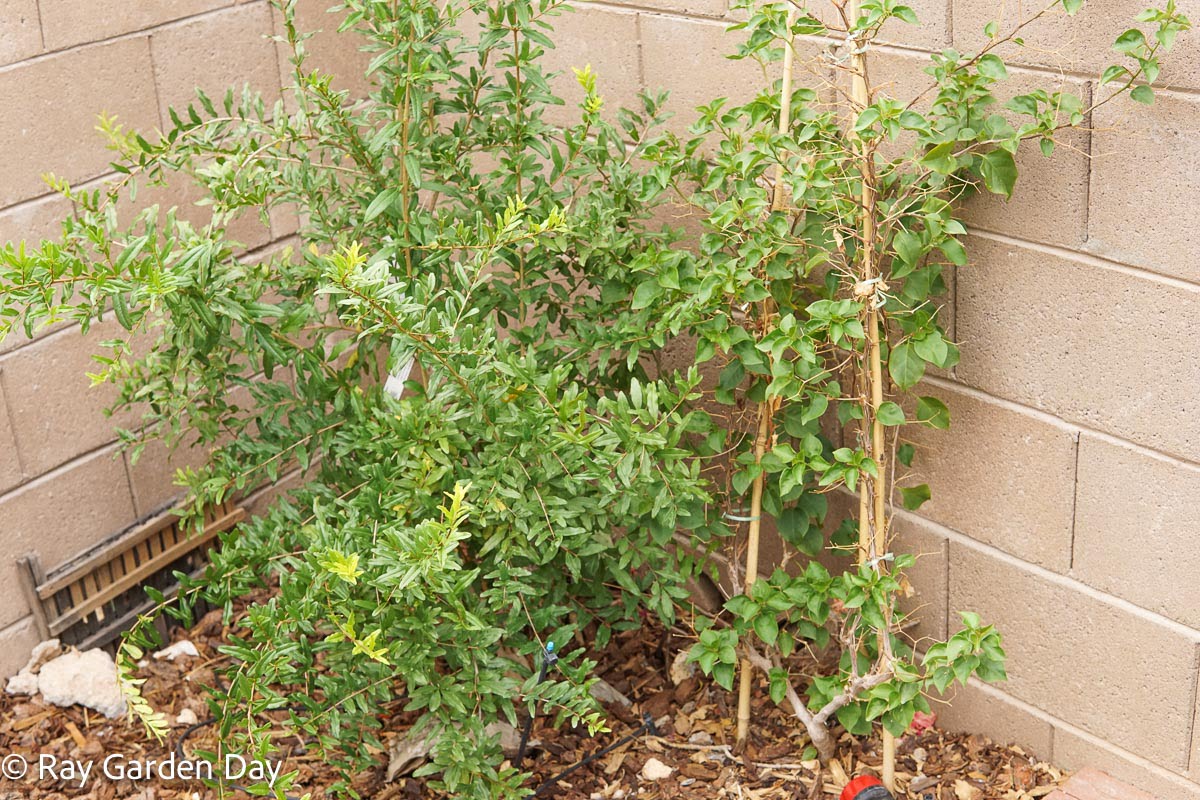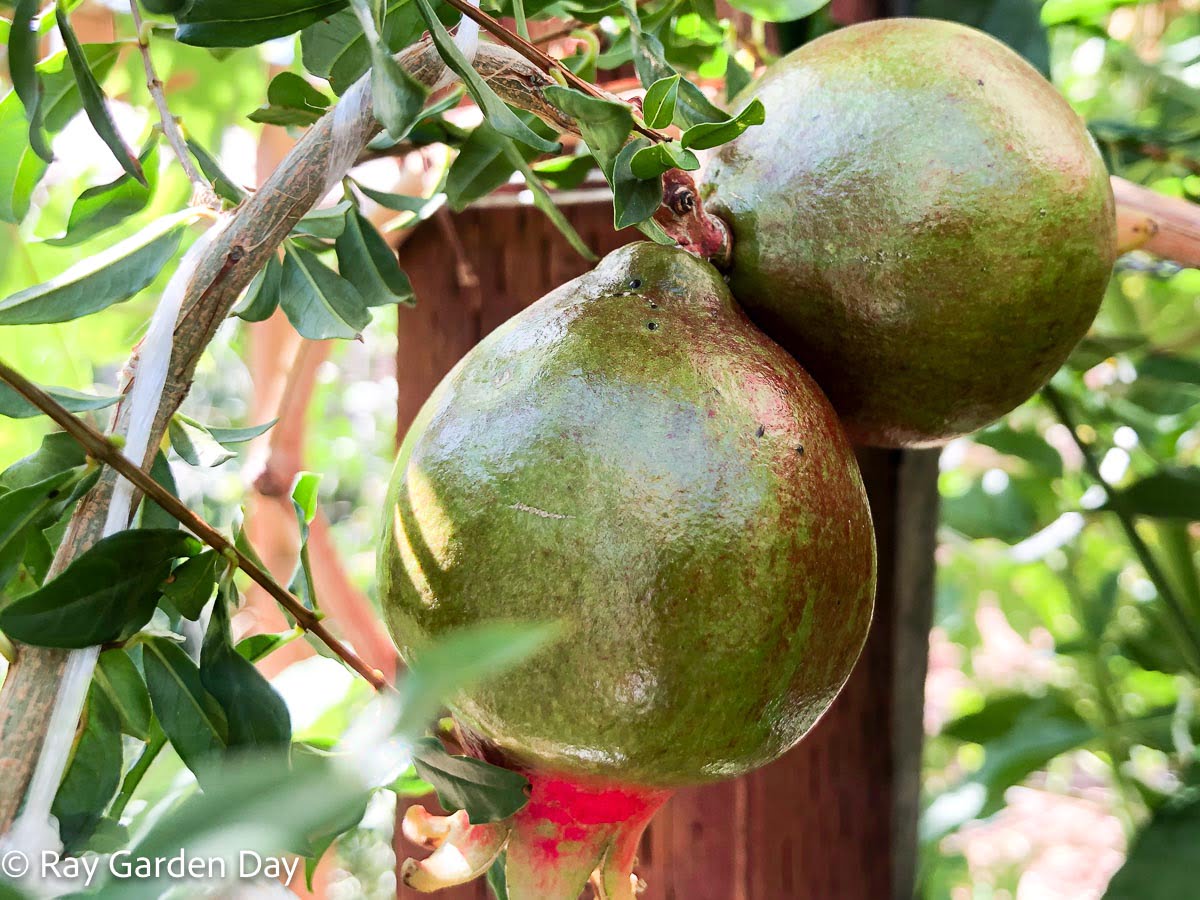There are at least 13 popular garden varieties of pomegranate to grow. For instance, the Wonderful is the most popular and commonly available pomegranate. Then, there’s a cultivar that produces record-breaking fruits.
Some types of pomegranate fruit trees bear fruit colors from yellowish pink to a deep burgundy. Other varieties of pomegranate trees bear fruit with flavors ranging from sweet to tart and taste like apple to wine.
Many pomegranate cultivars may have soft to hard arils. To eat fresh, I recommend choosing a plant with soft arils. For anything else, such as juicing, it doesn’t matter.
Dwarf pomegranate trees reach a height and width of just 3 feet. Yet, the heaviest pomegranate weighs 2.60 kg (5.73 lb), imagine the size of the mother tree, and grown in China, as verified on 27 November 2017.
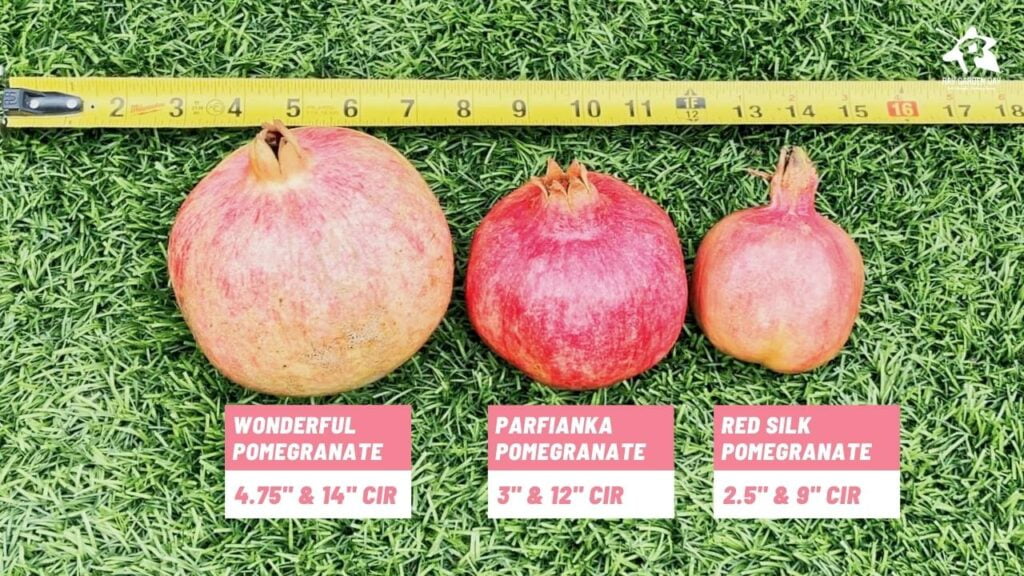
In the world of pomegranates, 1,117 pomegranate varieties from 27 countries were the official count, by Dr. Gregory Levin, a Russian-born botanist.
There are many things to consider when choosing the right variety of pomegranate trees for the garden. Below are some of the varieties of pomegranate available but by no means a comprehensive list.
Varieties of Pomegranate (A-Z)
Angel Red
Angel Red pomegranate is a heavy producer with dark red fruit and rinds. Arils contain high juice content makes them ideal for juicing. Grows at a moderate pace up to 10 feet tall and blooms in late summer. Harvest in late fall.
Al Sirin Nar
Al Sirin Nar is another pomegranate cultivar from the Turkmenistan stable. Has large and glossy red fruit. Sweet-tart taste arils that are very hard. For this reason, many gardeners prefer to juice rather than eating fresh.
Ariana
Arian pomegranates produce medium to large fruit with yellowish pink skin and dark red arils. Ariana and Desertnyi are two varieties with very soft seeds. The flavor is sweet-tart and delicious. Fruit ripens mid to late October.
Desertnyi
Desertnyi pomegranate is from the same Turkmenistan collection as Ariana. Bears medium to large orange fruit with light orange skin and dark red arils. Very soft seed with an excellent sweet-tart balance with citrus overtones. Desertnyi can reach up to 10 ft. in height and ripen in late fall.
Gissarskii Rozovyi
Gissarskii Rozovyi pomegranate fruit is medium with a yellow – pale pink rind that is prone to cracking. Arils are large pink with sweet-tart soft seeds. Does not require heat to ripen makes it ideal for growing in milder climates.
Golden Globe
Golden Globe pomegranate is a good choice for gardeners living in milder climates, particularly coastal regions. It has soft arils born from medium to large fruit.
Granada
Granada pomegranate is a mutation of Wonderful as an early-season crop. Also, darker color blossom and fruit. Soft arils and less tart. Ripen in August/September.
Kashmir
Kashmir pomegranate is a medium-sized fruit with a light pink-red rind. Bright red arils have an intense tart to sour flavor. Ideal for cooking or juicing. Smaller tree with a growth habit of a shrub or prune as a small tree.
Medovyi Vahsha
Medovyi Vahsha pomegranate, whose name means honey and as the name suggests, produces sweet arils and soft seeds make this one of the best for fresh eating. Medium pink-red fruits with.
Myatadzhy
Myatadzhy pomegranate is the perfect combination of sweet taste and color and somewhat hard to find a nursery that stocks it. Medium size fruit, pale pink to red rind color. Deep red arils are sweet and soft seeds. Ripen mid-October.
Parfianka
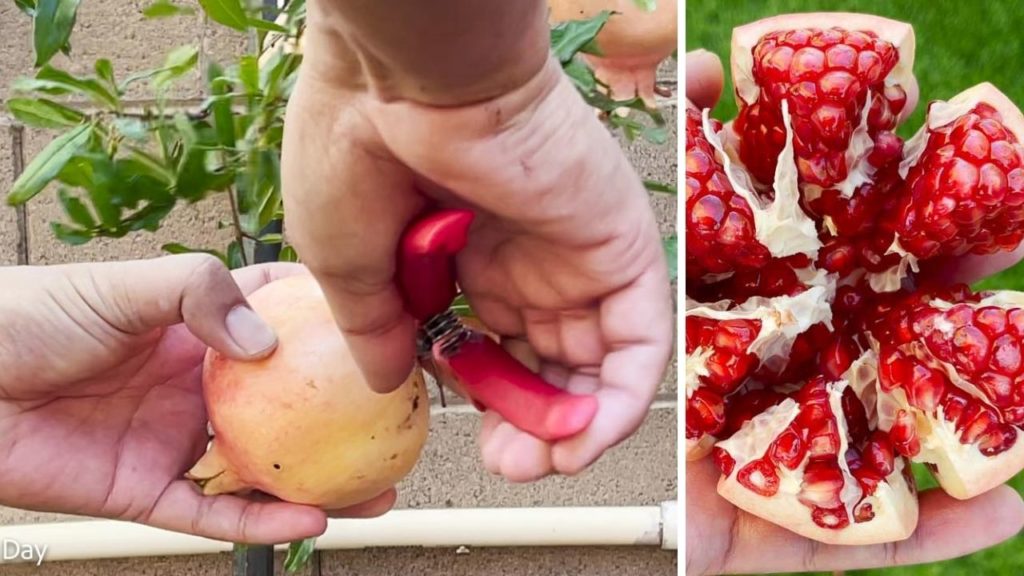
Parfianka pomegranate is one of the highly rated for its taste and is popular throughout the world. Yet another variety from Dr. Gregory Levin’s breeding program in Turkmenistan. Medium to large fruit, very soft dark red arils that are sweet-tart to sweet flavor. We have an almost 2 y/o Parfianka pomegranate tree growing in the backyard. It went from 2 to 8 feet in a season. A fast-growing pomegranate tree indeed.
Phoenicia
Phoenicia pomegranate produces medium to large fruit with yellowish -pale pink rind. The cultivar was one of the finalists in a taste test, the other two were Wonderful and cv. 857. In the study, panelists were asked to evaluate the fruits on a nine-point hedonic scale based on the following categories: color, sweetness, tartness, seed hardness, bitterness, and overall desirability. Suitable for coastal regions.
Red Silk
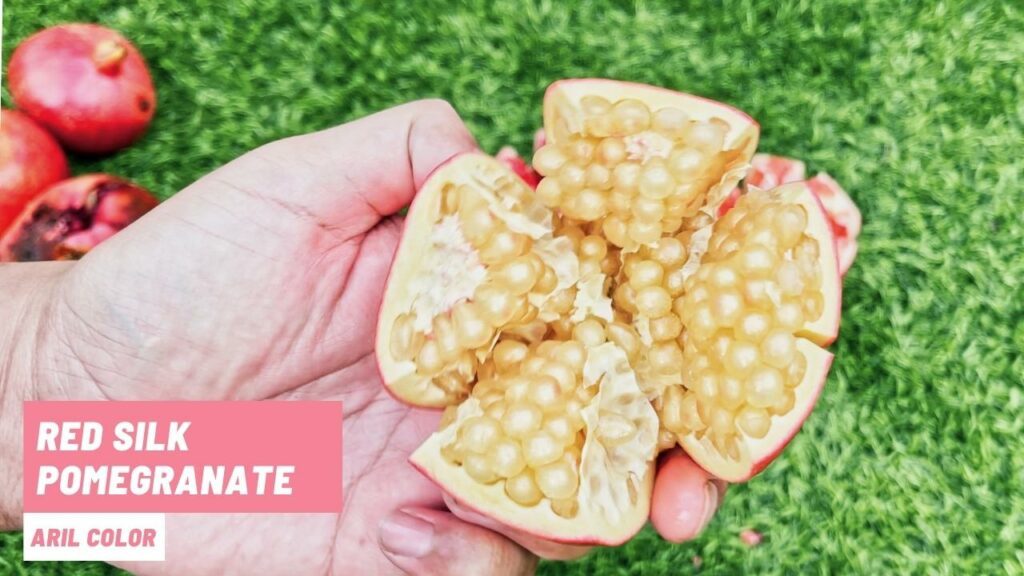
Red Silk pomegranate is a medium to large-sized fruit with a brilliant red silky exterior. Arils are mellow in taste, a sweet berry-like flavor. Heavy-bearing, mature height 15/20 ft. Tolerates heat and humidity and grows well in almost any soil. We planted a single-trunk Red Silk pomegranate tree in the backyard.
Sharp Velvet
Sharp Velvet Pomegranate fruit is medium-sized to large dark red exterior and burgundy arils. Sweet-sweet-tart fresh flavor. Minimal splitting and store well. The tree grows more upright than other varieties and is also more productive.
Sirenevyi
Sirenevyi pomegranate is a late harvest variety that ripen in November. Medium to large fruit with tan blushed pink exterior. Sweet dark purple and very soft seeds.
Wonderful
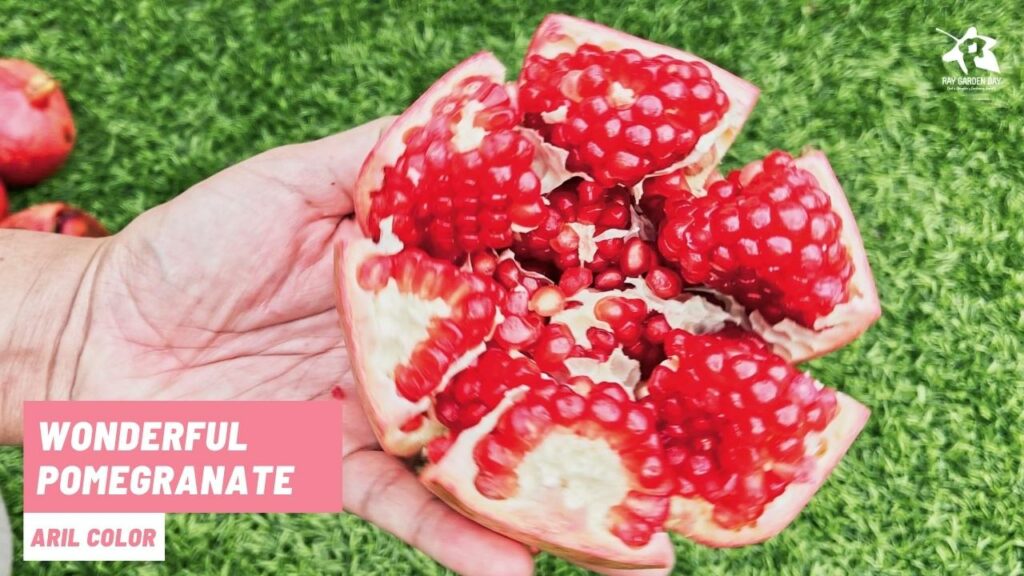
Wonderful pomegranate, a very popular cultivar grown in commercial and home garden. Large, purple-red fruit with delicious, sharp-tart flavor. Vigorous and productive trees with fruit that is more resistant to mature fruit cracking after rainfall. We have two plants growing; one in-ground and the other in a container. If you ever had and enjoyed the POM juice sold in grocery stores, the fruit juice is from Wonderful pomegranate.
FAQ
How pomegranate grow?
Pomegranate trees are perennial that can also be grown as shrubs. They are deciduous which means they shed their leaves at the end of the growing season in the fall. Pomegranates can be grown in mild-temperate to tropical climates. Regions with cool winters and hot, dry summers (California, Arizona, Utah, Nevada) produce best quality pomegranate fruit.
Where pomegranate grow in the U.S?
California produces more than 90 percent of the pomegranates grown in the United States. A few other states have small growing regions in Arizona, Utah, Nevada and Georgia. The optimal growing areas for most pomegranate cultivars are in USDA Zones 8 to 10.
How fast does pomegranate grow?
As a shrub, the growth rate of a pomegranate is between 1-3 feet per year. When pruned as a single-trunk to promote upright growth habit, you can expect at least 2-4 feet of growth in a single season.
Where do most pomegranates come from?
Pomegranate originated from the hills and valleys of Central Asia and is one of the last places on earth where it still grows wild. Cultivation spread to India and China where it is called Chinese apple in British English. The world’s largest collection of pomegranates includes 1117 varieties from 27 countries.
How to tell when a pomegranate is ripe?
Judging ripeness by color will get you close but it’s not the most reliable method. One way to tell if the fruit is ripe for picking is when it becomes slightly square caused by the arils inside becoming full of juice. The outer skin will also feel smooth because of the built-up pressure from plump aril sacs. There’s a visible brown ring where the stem meets the fruit aka sugar ring. See When to Harvest Parfianka Pomegranate.
Which pomegranate is best for juicing?
Angel Red arils contain high juice content makes them ideal for juicing. Less pulp with seeds soft enough to be eaten fresh. Kashmir pomegranate is also good for cooking or juicing.



